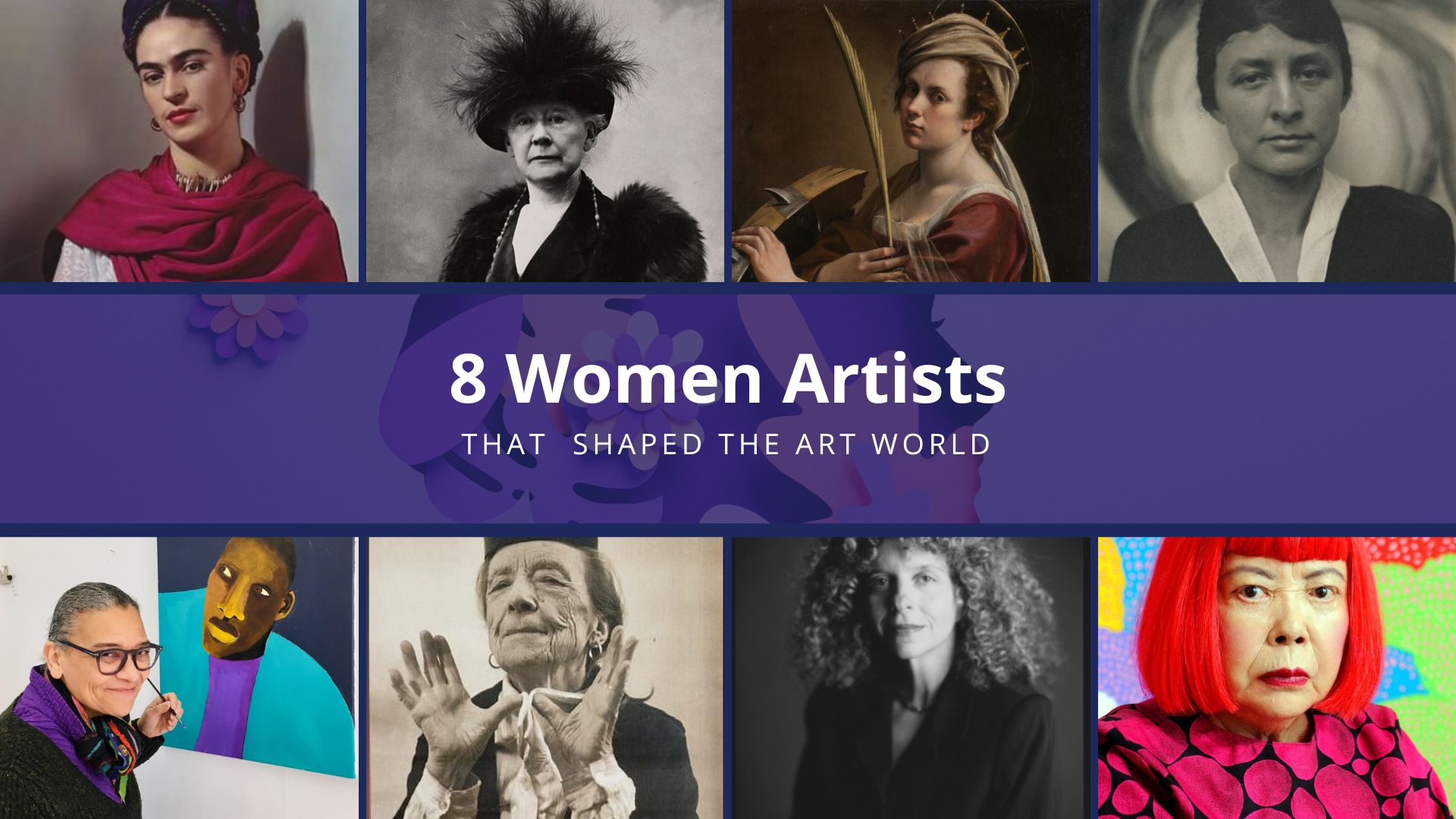The world of fine art is a vast and diverse landscape, filled with countless artists who have made their mark on history. But among them, there are certain figures who stand out as truly groundbreaking and influential, women who have defied convention, challenged societal norms, and left an indelible mark on the art world and beyond.
In celebration of International Women’s Day on March 8th, The Fine Art Auction has chosen to honor eight of the most famous and influential female artists throughout history. From the bold and colorful works of Frida Kahlo to the surreal and dreamlike art of Yayoi Kusama, these women have each contributed something unique and significant to the world of art.
Mary Cassatt, Artemisia Gentileschi, Georgia O’Keeffe, Lubaina Himid, Louise Bourgeois, and Barbara Kruger are just a few of the other artists whose groundbreaking work will be celebrated and explored in this special event.
Join us as we take a closer look at the art, lives, and legacies of these incredible women, and pay tribute to their powerful contributions to the world of fine art.
The most influential period and timeframe of Mary Cassatt‘s life was the late 19th century. During this time, Cassatt was active as a painter and printmaker and was a leading member of the Impressionist movement.
Cassatt was heavily influenced by the Impressionist style, with its focus on light and color, and she is best known for her depictions of women and children in intimate, domestic settings. Her paintings and prints from this period, such as “The Child’s Bath,” “The Child’s Next-to-Last Things,” and “The Tea,” are considered some of her most important and influential works.
In addition to her artistic contributions, Cassatt also played a role in promoting the Impressionist movement. She helped to organize exhibitions and was instrumental in introducing the work of her fellow Impressionist artists to American collectors.
Overall, the late 19th century was a highly influential period in Mary Cassatt’s life, during which she produced some of her most famous and important works, helped to promote the Impressionist movement, and established herself as a leading figure in the world of art.
One of the most influential aspects of Artemisia Gentileschi‘s career was her ability to rise to prominence in a male-dominated field. As a female artist in 17th century Italy, Gentileschi faced many challenges and obstacles that her male counterparts did not. Despite this, she was able to establish a successful career and gain recognition for her work.
Gentileschi’s art is also notable for its unique perspective and subject matter. She often depicted strong, heroic women in her paintings, which was unusual for the time. Her work often explored themes of female empowerment and agency, and she is credited with helping to create a new style of art that focused on the experiences and perspectives of women.
Gentileschi’s personal story was also influential. She was the victim of sexual assault at a young age, and the subsequent trial and public humiliation that followed had a profound impact on her life and art. Her ability to channel this experience into her work and use it as a source of strength and inspiration is a testament to her resilience and determination.
Overall, Gentileschi’s career and art were influential in their ability to challenge societal norms and expectations, and to give voice to women’s experiences and perspectives. Her work continues to inspire and resonate with audiences today.
Georgia O’Keeffe is a truly iconic figure in the world of art. Her work is instantly recognizable and has had a profound impact on the art world and popular culture as a whole.
O’Keeffe’s art is notable for its bold colors, abstract shapes, and unique perspective. She often painted natural forms, such as flowers and landscapes, in a way that was both realistic and abstract, blurring the lines between representation and abstraction.
O’Keeffe was also a trailblazer for women in the arts. She achieved great success and recognition during her lifetime, at a time when women were often marginalized in the art world. She paved the way for future generations of female artists, inspiring them to pursue their own creative paths and challenge the status quo.
Today, O’Keeffe’s legacy continues to inspire and captivate audiences around the world. Her art remains as relevant and powerful as ever, and her influence can be seen in the work of countless artists who have followed in her footsteps.
Frida Kahlo is widely recognized as one of the most influential women artists of the 20th century. Her unique style, vibrant colors, and deeply personal subject matter have inspired countless artists and captivated audiences around the world.
What makes Kahlo’s legacy even more remarkable is the fact that she created much of her art in a time when women were not widely accepted as artists. Despite facing significant challenges and barriers due to her gender, Kahlo persevered and continued to create some of the most powerful and moving works of art of her time.
Her ability to portray her own life experiences and innermost emotions in her art has made her a symbol of strength and resilience for women around the world. Her willingness to be vulnerable and honest about her struggles with physical and emotional pain has resonated with countless people who have faced similar challenges in their own lives.
Kahlo’s influence extends far beyond the art world. She has become a cultural icon, a symbol of feminist empowerment, and a beacon of hope for anyone who has ever felt marginalized or oppressed. Her life and art serve as a powerful reminder of the importance of perseverance, creativity, and authenticity in the face of adversity.
Lubaina Himid is a British artist and activist whose work has had a profound impact on the art world and beyond. As a black woman working in a predominantly white male field, she has faced many challenges and obstacles, but has persevered and become a trailblazer for other artists and activists.
Himid’s work explores issues of race, gender, and identity, often drawing on her own personal experiences and the experiences of others in her community. She is known for her use of bold colors and striking imagery, and for her ability to make powerful statements about social and political issues through her art.
In addition to her work as an artist, Himid is also a curator and a professor of contemporary art. She has worked tirelessly to support and promote other artists of color, and to create spaces for their work to be seen and appreciated.
Overall, Himid’s influence and significance cannot be overstated. Her art and activism have helped to pave the way for other artists and activists, and have given voice to underrepresented communities. Her legacy will continue to inspire and motivate generations to come.
Louise Bourgeois is a towering figure in the world of contemporary art. Her work is known for its raw, emotional intensity, and for its ability to explore complex themes of sexuality, motherhood, and the human psyche.
Bourgeois’ influence and significance cannot be overstated. She was a pioneering figure in the feminist art movement, and her work has helped to expand the boundaries of what art can be and what it can say. Her art often challenges traditional gender roles and expectations, and has given voice to underrepresented perspectives and experiences.
In addition to her art, Bourgeois was also an accomplished writer and thinker. She wrote extensively about her art and her life, and her writing has had a profound impact on the art world and beyond.
Overall, Bourgeois’ legacy continues to inspire and challenge artists and audiences around the world. Her work remains as relevant and powerful as ever, and her influence will continue to be felt for generations to come. Let us celebrate the life and work of this visionary artist, who dared to push boundaries and create art that was both beautiful and profound.
Barbara Kruger is a contemporary artist known for her bold and thought-provoking works that challenge the viewer to think critically about issues of power, consumerism, and identity. Her signature style involves combining black-and-white photographs with provocative slogans rendered in bold, capital letters, often using the colors red and white.
Kruger’s work has been described as a form of cultural critique, challenging the status quo and questioning the way we think about ourselves and the world around us. She has been a pioneer in the use of photography and design in the world of contemporary art, and her influence can be seen in the work of countless artists who have followed in her footsteps.
What is particularly significant about Kruger’s work is its focus on issues of gender and identity. Through her art, she has explored the ways in which women are objectified and commodified in our society, challenging traditional notions of beauty and power. Her works often feature slogans that draw attention to the ways in which women are marginalized or oppressed, calling on viewers to question their own assumptions and biases.
Kruger’s impact extends far beyond the world of art. Her work has inspired countless people to think more deeply about issues of power and identity, and her influence can be seen in the worlds of fashion, advertising, and popular culture. Her legacy as a feminist artist and cultural critic is one that continues to inspire and challenge us to this day.
Yayoi Kusama is a contemporary artist who is known for her unique and innovative approach to art, particularly in the realm of sculpture and installation art. She is one of the most prominent and influential artists of our time, and her work has had a profound impact on the art world and popular culture.
One of the most notable aspects of Kusama’s work is her use of repetitive patterns and motifs, often featuring dots or bright colors, which create an immersive and otherworldly experience for the viewer. Her work is often inspired by her own experiences with mental illness, which has been a significant theme throughout her artistic career.
Kusama’s work is also notable for its feminist and political themes. Her installations and sculptures often address issues of gender, sexuality, and power, challenging traditional notions of beauty and order. Through her art, she has explored the ways in which women are objectified and oppressed, and has called attention to the need for greater equality and social justice.
Kusama’s influence can be seen in the work of countless contemporary artists, who have been inspired by her innovative approach to art and her willingness to push boundaries and challenge conventions. Her legacy as a feminist artist and cultural icon is one that continues to inspire and empower people around the world, and her work serves as a reminder of the transformative power of art to effect social change.

